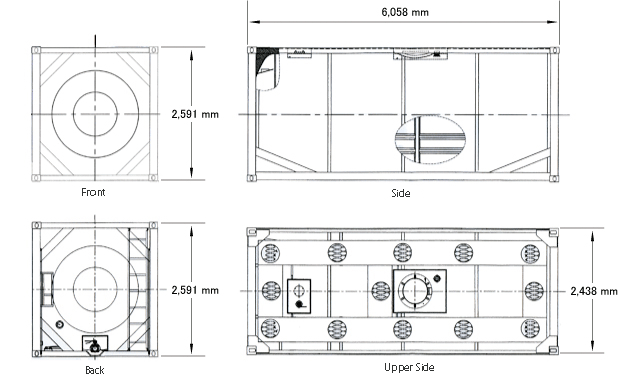While tank containers are known for transporting liquid products, ISO tank containers are built based on ISO standards (International Organization for Standardization) and are designed to carry liquids in bulk, both hazardous and non-hazardous.
Frame – in accordance with: ISO Standard 1496/3 1.2 ISO Type 1CC / 22T6 1.3 IMO Type 1 SI US 1.4 Nominal Capacity (-0 +1% Tolerance) 24 000 6340 US gal 1.5 Frame Dimensions and Weight Max Gross Weight 36 000kg 79366 lb. Tare Weight (± 3% Tolerance) 3840 kg 8466 lb. Length 6058 mm 20 ft Width 2438 mm 8 ft Height 2591 8 ft 6 in 1.6 Tank Dimensions. 4.3 The tank container has been specially tested and approved for a stacking load of 86400kg per corner post, which corresponds to nine-high stacking. 4.4 The tank container fulfils the performance specification of the following International Organization’s regulations and recommendations and is supplied with their Approvals / Registrations.
These containers are made of stainless steel and are surrounded by various types of protective layers. Based on the cargo type, different skins can be used. The container has a manhole on the top along with at least one valve and another valve on the bottom. They are shaped like a cylinder. Since ISO tanks are built based on ISO standards, the frame which the tank sits in measures about 6 meters long, 2.4 meters wide and between 2.4 – 2.5 meters high and vary in size and type and can carry between 21,000 and 40,000 liters of liquid.
Below are the types of liquids can be carried in ISO tank containers.
ISO CONTAINER CAD DRAWINGS. I have been inundated with container drawing requests and for this reason I have decided that I will no longer supply anyone with any container detail drawings. So, please do not contact me anymore. I will however provide these drawings to this site if they can store them. By the mid 60’s the first tank Containers were being built - a cylindrical vessel set within the ISO frame. The ISO Tank Container was developed for the carriage of all types of liquids, ranging from, but not limited to, portable (food grade) liquids, non hazardous, and hazardous liquids, including. Hillebrand shipping services include ISO tanks, which are an effective transportation method for your liquids classed as non-hazardous. Suitable for sea, road and rail transportation, ISO tank containers are reusable and have a robust design. See transport modes.
1. Molasses
2. Milk and other dairy products
3. Alcoholic and Non-Alcoholic Beverages
4. Liquefied sugars
5. Hydrogen Peroxide
6. Sulphur Acid / Nitric Acid
7. Chemicals / Solvents
8. Liquid Food Products
9. Heating oil / Vegetable oils
10. Gasoline / Diesel / Liquefied petroleum gas
11. Liquid Resins
Below are some of the benefits of ISO tank containers.
Iso Tank Container Operators
1. ISO tank containers are a reliable, cost-effective (depending on the product being shipped) and definitely safe way of transporting bulk liquids.
2. ISO tanks are designed to meet specific criteria according to the substance they will be carrying.

Iso Tank Container Cad Drawing
3. Because of the above, ISO tanks are very reliable and can withstand extreme pressure and damage.

4. ISO tanks are highly unlikely to leak and do not require additional packaging materials for cargo.
Iso Container Tank Drawings
5. ISO tanks maintain a specific temperature for temperature-sensitive cargo and can be transported by land or ocean.
Flexitanks vs. ISO Tank Containers for Bulk Liquid Transportation
Since ISO tank containers are often compared with Flexitanks, I would say this comparison can be applied depending on the product type along with the Origin/Destination of the shipment. Flexitanks and tank containers are both used to transport bulk liquids. Depending on what you are shipping and the Origin/Destination, one method can be better than the other.

Bulk liquid transportation is an important segment of the freight transportation industry. Depending on the type of product being shipped, the origin of the product and the cargo’s destination, the most reliable and economical method of bulk liquid transportation may not be obvious.
While ISO tank containers and flexitanks are both used to efficiently transport bulk liquids, there are some distinct differences between these two options. Flexitanks are cost-effective when product is non-hazardous depending on the Origin/Destination. Due to high cost of repositioning tank containers back to origin of the cargo if there is no two-way business in Origin/Destination, these tanks need to be repositioned back to their origin or somewhere where tank container suppliers need. Therefore, this increases the cost of ocean freight. In this scenario, flexitanks can play a crucial role to maintain freight advantage versus tank containers.